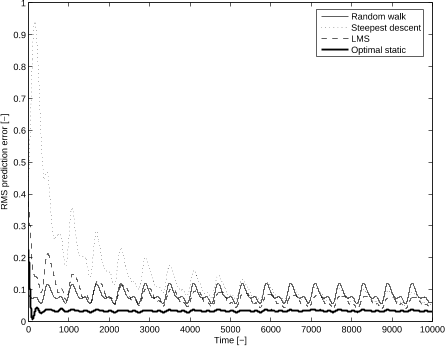




Did you find this useful? Give us your feedback







![Figure 3. Influence functions in [m/N] for the central actuator in a mirror with a hexagonal actuator grid with 61 actuators with a stiffness of 100, 500, 1000 and 2000 [N/m] from left to right and top to bottom respectively.](/figures/figure-3-influence-functions-in-m-n-for-the-central-actuator-lcp22u7d.png)







38 citations
25 citations
...The relation can then be inverted to yield: [ Fζ M ] = [ Ωζζ Uζ U ζ 0 ]−1 [ Hζ 0 ] = [ Km Kr ] Hζ , (2)...
[...]
...Substitution of (2) for Fζ into the force equilibrium in (3) yields Fa −CaHζ −KmHζ = 0 and thus the mirror deflection Hζ at the actuator positions is related to the actuator forces Fa via the influence matrix Bζ as:...
[...]
...The results from (2) can be substituted into the plate equation in (1) together with (4), yielding Hz = BzFa where Bz = (ΩzζKm+UzKr)Bζ ....
[...]
17 citations
17 citations
...2004, 2005a,b, 2006), (Ellenbroek et al. 2006) proposed a distributed control framework for AO in which each actuator has a separate processor that can communicate with a few direct neighbors....
[...]
14 citations
2,549 citations
...(20) As both Rk and ṽk converge to the best estimates for the covariance matrix R and correlation vector ṽ respectively for k → ∞, the adaptive filter should converge to the static solution as long as the step size α is chosen properly....
[...]
1,944 citations
1,054 citations
911 citations
...h(F, z, ζ) = F 16πR { (1 − r(2))(1 − ρ(2)) + [r2 + ρ(2) − 2rρ cos(φ − ψ)] ln r(2) + ρ(2) − 2rρ cos(φ − ψ) 1 + r2ρ2 − 2rρ cos(φ − ψ) } , (5)...
[...]
The undamped system has a highly oscillating step response, requiring over 100 times more actuator damping than that estimated in section 3.1 to suppress.
The actuators consist of a closed magnetic circuit in which a permanent magnet provides a static magnetic force on a ferromagnetic core which is suspended in a membrane.
But again due to the structure of A when the points in the phase grid are suitably ordered, this forward substitution problem can be written as a series of nf ≈ nw/2 elimination steps – where nw is the number of phase points over the diagonal of the grid.
(4)Although the face-sheet has only a slight thickness, it still has a considerable out-of-plane stiffness when and should be modeled as a thin plate.
For the static case, all time-derivative terms in (8) are zero and the deflection h can be directly expressed in terms of the forces Fa, from which the mirror influence matrix B containing the DM influence functions in its columns can be derived:B = (K−1 + Ca)−1. (9)The influence function of a mirror’s central actuator has been plotted for four values of ka in figure 3.
This paper reports on work that has been done in a joint project aimed at designing a new AO system that has an extendible design, which means that the same design should be applicable when the number of actuators is increased.
Models based on Kolmogorov statistics such as16,17 work well, but apart from pure frozen flow behavior it appears difficult to model the evolution of the disturbance over time.